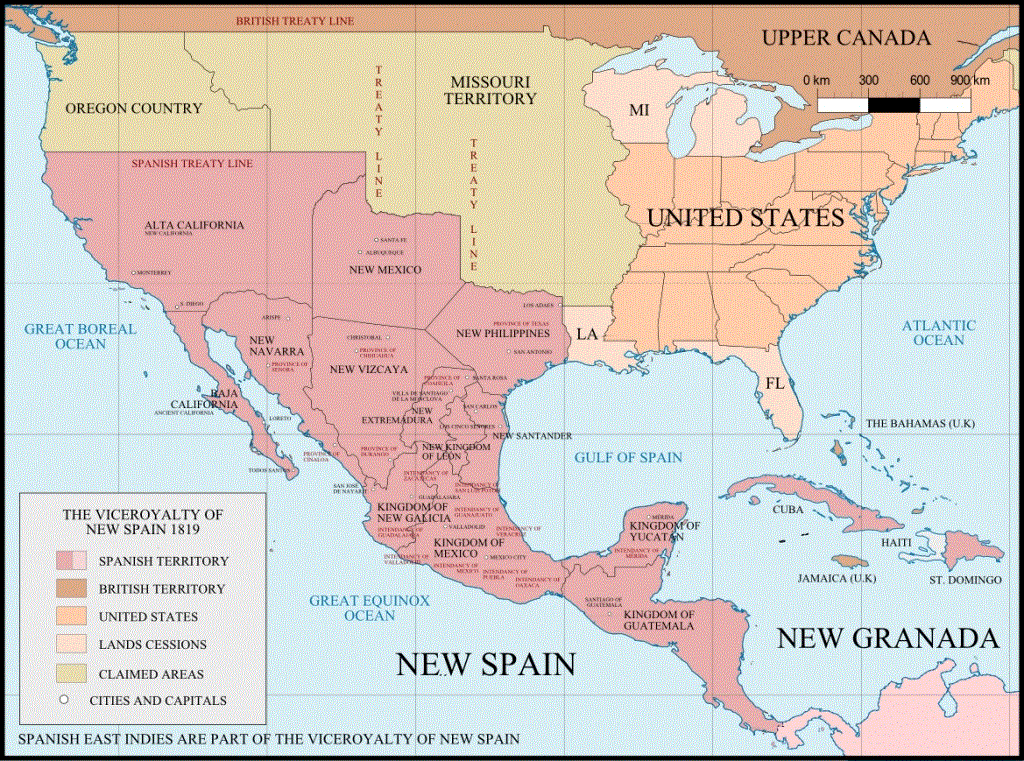

All the presidios were established on the same plan; choosing a favorable place, they surrounded it by a ditch, twelve feet wide and six deep. The earth of the ditch served for the outwork. The enclosure of the presidio was formed by a quadrilateral, about six hundred feet square. The rampart, built of brick, was twelve to fifteen feet high, by three in thickness; small bastions flanked the angles; the presidio had but two gates. Its armament generally consisted of eight bronze cannon, eight, twelve, and sixteen pounders. Although incapable of resisting an attack of ships of war, these fortifications were sufficient to repel the incursions of the Indians. Not far from the presidios, according to the topography of the land, was an open battery (batterie decouverte), pompously styled 'the castle' (castillo).[5]
Within the enclosure of the presidio was the church, the quarters of the officers and soldiers, the houses of colonists, storehouses, workshops, stables, wells and cisterns. Outside were grouped some houses, and at a little distance was the 'King's Farm' (El Rancho Del Rey), which furnished pasturage to the horses and beasts of burden of the garrison. Four coast batteries and four presidios defended “Alta California”: Those of San Diego, founded in 1769; Monterey in 1770; San Francisco in 1776; and Santa Barbara in 1780. [5]
1. The first step was the submitting of a petition by an applicant, containing the name, religion, residence occupation, and the size of the family. Along with a land description and, at times, a 'diseño' – a hand drawn topological map (see Figure 2). The 'diseño' and land description were usually very vague, calling to sloughs, trees, hills, and features which were not very permanent.

2. The second step was the inquiries by officials into the availability of the land, the character of the applicant, and the posting of the petition in case another party had objections to the approval of the application.
3. The third step was the ''Informe" which was usually a separate document or a note appended to the original application, stating the findings of the officials in Step Number 2. This third step usually entailed the actual concession of land or refusal of the concession of land.
4. The fourth and final step was the confirmation of the concession by the Viceroy. This final step made the title to the land perfect. The applicant or grantee was given possession by the Alcalde (local judge) who caused the grantee to pull up grass, throw stones, break twigs, and exclaim, "Viva el Presidente y la Nación Mexicana" (long live the President and the Mexican Nation). During the Mexican era, these four steps were also used with minor alterations.[5]
| Concession | Date | Grantor | Grantee | Size | Location | County |
| 1. San Pedro | 1784 | Pedro Fages | Juan Jose Dominguez | 48,000 acres (194 km2) | San Pedro, Torrance, Redondo Beach, Hermosa Beach, Manhattan Beach, Lomita, Gardena, Harbor City, Wilmington, Carson, Compton | Los Angeles |
| 2. Los Nietos | 1784 | Pedro Fages | Manuel Nieto | 167,000 acres (676 km2) | Long Beach, Lakewood, Downey, Norwalk, Santa Fe Springs, Whittier, Fullerton, Huntington Beach, Seal Beach, Anaheim, Buena Park, Garden Grove, Artesia, Cerritos | Orange |
| 3. San Rafael | 1784 | Pedro Fages | José María Verdugo | 36,403 acres (147 km2) | Atwater Village, Eagle Rock, Glassell Park, Glendale, Highland Park | Los Angeles |
| 4. Nuestra Señora del Refugio | 1794 | José Francisco Ortega | 26,529 acres (107 km2) | Refugio State Beach | Santa Barbara | |
| 5. Los Feliz | 1795 | Pedro Fages | Jose Vicente Feliz | 6,647 acres (27 km2) | Los Angeles, Los Feliz | Los Angeles |
| 6. Simi | 1795 | Diego de Borica | Patrico, Miguel, and Francisco Javier Pico | 113,009 acres (457 km2) | Simi Valley, Moorpark | Ventura |
| 7. Buena Vista | 1795 | Jose Maria Soberanes & Joaquin Castro | 8,446 acres (34 km2) | Spreckels | Monterey | |
| 8. Las Salinas | 1795 | Antonio Aceves and Antonio Romero | 17,712 acres (72 km2) | Monterey, Salinas | Monterey | |
| 9. Las Pulgas | 1795 | Diego de Borica | José Dario Argüello | 35,000 acres (142 km2) | San Mateo, Belmont, San Carlos, Redwood City, Atherton, Menlo Park | San Mateo |
| 10. Las Virgenes | 1802 | José Joaquín de Arrillaga | Miguel Ortega | 17,760 acres (72 km2) | Agoura Hills, Oak Park, Westlake Village | Los Angeles |
| 11. El Conejo | 1802 | Ygnacio Rodriguez and Jose Polanco | 48,672 acres (197 km2) | Newbury Park, Thousand Oaks, Lake Sherwood, Westlake Village, Oak Park | Ventura | |
| 12. Topanga Malibu Sequit | 1802 | José Bartolomé Tapia | 13,300 acres (54 km2) | Malibu | Los Angeles | |
| 13. Las Animas | 1803 | Feliz Berengue | Mariano Castro | 24,066 acres (97 km2) | Gilroy | Santa Clara |
| 14. Los Palos Verdes | 1809 | José Dolores Sepúlveda | 31,629 acres (128 km2) | Part of Rancho San Pedro | Los Angeles | |
| 15. San Ysidro | 1809 | José Joaquín de Arrillaga | Ygnacio Ortega | 13,066 acres (53 km2) | Gilroy | Santa Clara |
| 16. San Antonio | 1810 | Antonio María Lugo | 29,513 acres (119 km2) | Bell, Bell Gardens, Commerce, Cudahy, East Los Angeles, Lynwood, Montebello, South Gate, Vernon | Los Angeles | |
| 17. Santiago de Santa Ana | 1810 | José Antonio Yorba & Juan Pablo Peralta (Nephew) | 63,414 acres (257 km2) | Santa Ana, El Modena, Orange, Irvine, Costa Mesa, Tustin, Olive. | Orange | |
| 18. La Ballona | 1819 | Machado and Talamantes families | 13,920 acres (56 km2) | Culver City, Inglewood, Marina del Rey, Palms, Playa del Rey, Santa Monica (Ocean Park Dist), Venice | Los Angeles | |
| 19. San Antonio | 1820 | Pablo Vicente de Solá | Luís María Peralta | 44,800 acres (181 km2) | Albany, Alameda, Berkeley, Emeryville, Oakland, Piedmont, San Leandro | Alameda |
| 20. Rincon de los Bueyes | 1821 | Pablo Vicente de Solá | Bernardo Higuera and Cornelio Lopez | 3,127 acres (13 km2) | Cheviot Hills, Rancho Park, Culver City, Baldwin Hills | Los Angeles |
| 21. Vega del Rio del Pajaro | 1821 | Pablo Vicente de Solá | Antonio Maria Castro | 4,310 acres (17 km2) | Monterey, Watsonville | Monterey |
| 22. Los Tularcitos | 1821 | Pablo Vicente de Solá | José Higuera | 4,394 acres (18 km2) | Milpitas | Santa Clara |
| 23. Sausal Redondo | 1821 | Antonio Ygnacio Avila | 22,458 acres (91 km2) | Manhattan Beach, Lawndale Beach, Hermosa Beach | Los Angeles |

1. Mission San Diego, in San Diego County, founded under Carlos III, July 16, 1769; containing 22.21 acres. Patented May 23, 1862.
2. Mission San Luis Rey, in San Diego County, founded under Carlos IV, June 13, 1798; containing 53.39 acres. Patented March 3, 1865.
3. Mission San Juan Capistrano, in Orange County, founded under Carlos III, November 10, 1776; containing 44.40 acres. Patented March 18, 1865.
4. Mission San Gabriel Arcangel, in Los Angeles County, founded under Carlos III, September 8, 1771; containing 190.69 acres. Patented November 19, 1859.
5. Mission San Fernando, in Los Angeles County, founded under Carlos IV, September 8, 1797; containing 76.94 acres. Patented May 31, 1864.
6. Mission San Buenaventura, in Ventura County, founded under Carlos III, March 31, 1782; containing 36.27 acres. Patented May 23, 1862.
7. Mission Santa Barbara, in Santa Barbara County, founded under Carlos III, December 4, 1786; containing 283.13 acres. Patented March 18, 1865.
8. Mission Santa Inez, in Santa Barbara County, founded Carlos IV, September 17, 1804; containing 17.34 acres. Patented May 23, 1862.
9. Mission La Purisima Concepcion, in Santa Barbara County, founded under Carlos III, December 8, 1787; containing 14.04 acres. Patented January 24, 1874.
10. Mission San Luis Obispo, in San Luis Obispo County, founded under Carlos III, September 1, 1772; containing 52.72 acres. Patented September 2, 1859.
11. Mission San Miguel Arcangel, in San Luis Obispo County, founded under Carlos IV, July 25, 1797; containing 33.97 acres. Patented September 2, 1859.
12. Mission San Antonio de Padua, in San Luis Obispo County, founded under Carlos III, July 14, 1771; containing 33.19 acres. Patented May 31, 1862.
13. Mission La Soledad, in Monterey County, founded under Carlos IV, October 9, 1791; containing 34.47 acres. Patented November 19, 1859.
14. Mission El Carme or San Carlos de Monterey, in Monterey County, founded under Carlos III, June 3, 1770; containing 9 acres. Patented October 19, 1859.
15. Mission San Juan Bautista, in San Benito County, founded under Carlos IV, June 24, 1797; containing 55.23 acres. Patented November 19, 1859.
16. Mission Santa Cruz, in Santa Cruz County, founded under Carlos IV, August 28, 1791; containing 16.94 acres. Patented September 2, 1859.
17. Mission Santa Clara, in Santa Clara County, founded under Carlos III, January 18, 1777; containing 19.95 acres. Patented March 3, 1858.
18. Mission San Jose, in Alameda County, founded under Carlos IV. June 22, 1797; containing 28.33 acres. Patented.
19. Mission Dolores or San Francisco de Assisi, in San Francisco County, founded under Carlos III, October 9, 1776; two lots, one containing 4.03 acres and the other 4.51 acres. Patented March 3, 1858.
20. Mission San Rafael Arcangel, in Marin County, founded under Fernando VII, December 18, 1817: containing 6.48 acres. Patented October 19, 1859.
21. Mission San Francisco Solano, in Sonoma County, founded under Fernando VII, August 25, 1813; containing 14.20 acres. Patented May 31,1862.
1. Presidio of San Diego in San Diego County, founded July 16, 1769: patented April 10, 1874 to the City of San Diego; containing 47,323.08 acres.
2. Pueblo of Los Angeles in Los Angeles County, founded in 1781; patented August 4. 1875 to the City of Los Angeles; containing 17,172.37 acres.
3. Pueblo of San Jose in Santa Clara County, founded in 1777; patented July 4, 1884 to the City of San Jose; containing 55,891.77 acres.
4. Presidio of Monterey in Monterey County, founded June 3, 1770; patented November 19, 1891 to the City of Monterey; containing 29,698.53 acres.
5. Presidio of Santa Barbara in Santa Barbara County, founded April 19, 1782; containing 17,826.17 acres; patented June 31, 1872 to the City of Santa Barbara.
6. Presidio of San Francisco in San Francisco County, founded on September 17, 1776; patented June 20, 1884 to the City of San Francisco; containing 17,754.36 acres.
7. Pueblo of Sonoma in Sonoma County, founded in 1835 by the Mexican government; patented March 31, 1880 to the City of Sonoma; containing 6,063.95 acres.
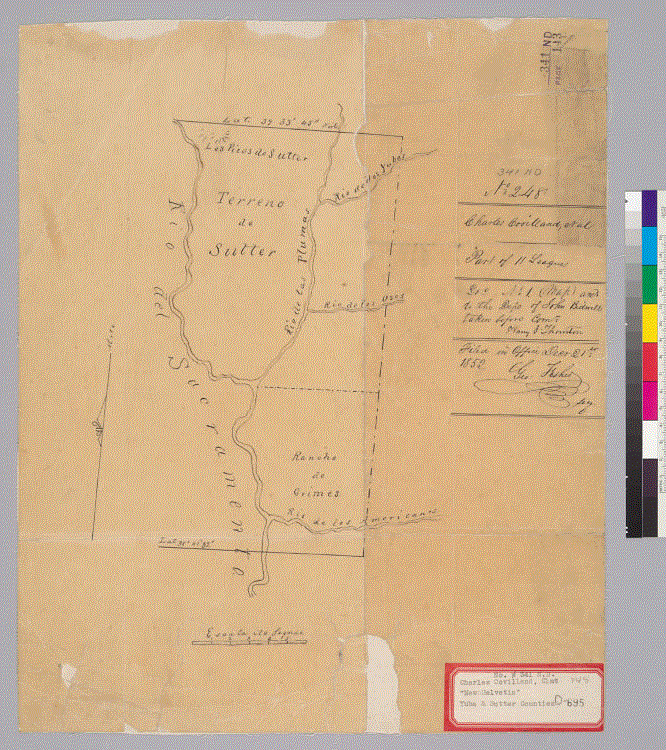
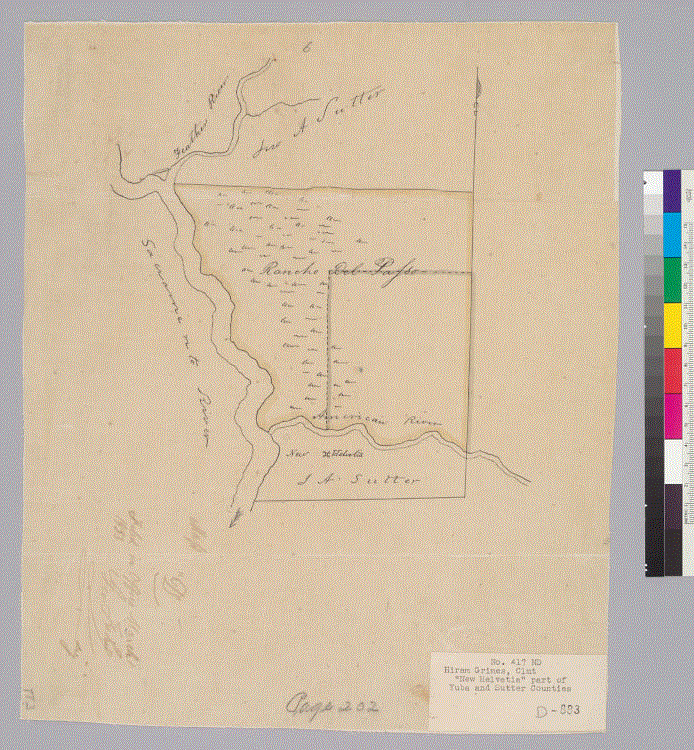
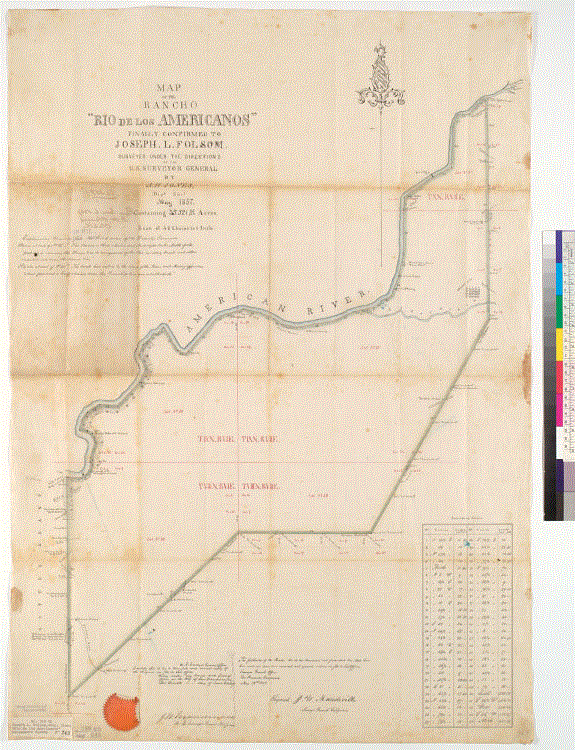

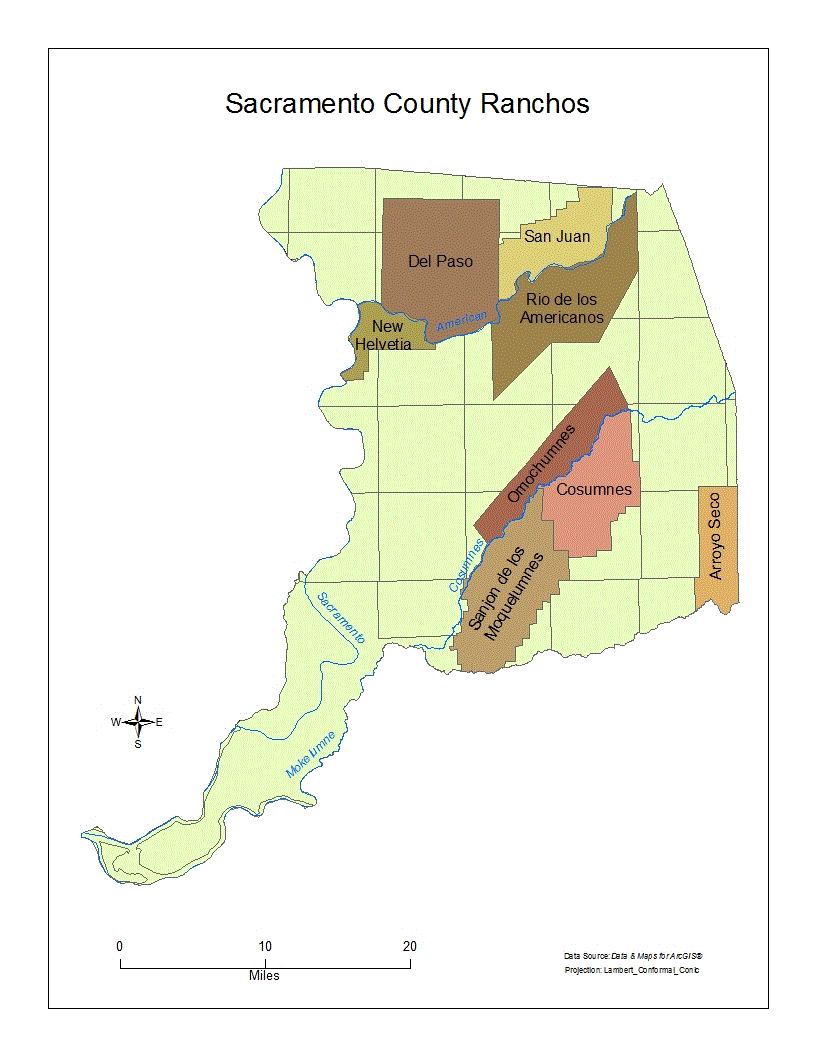
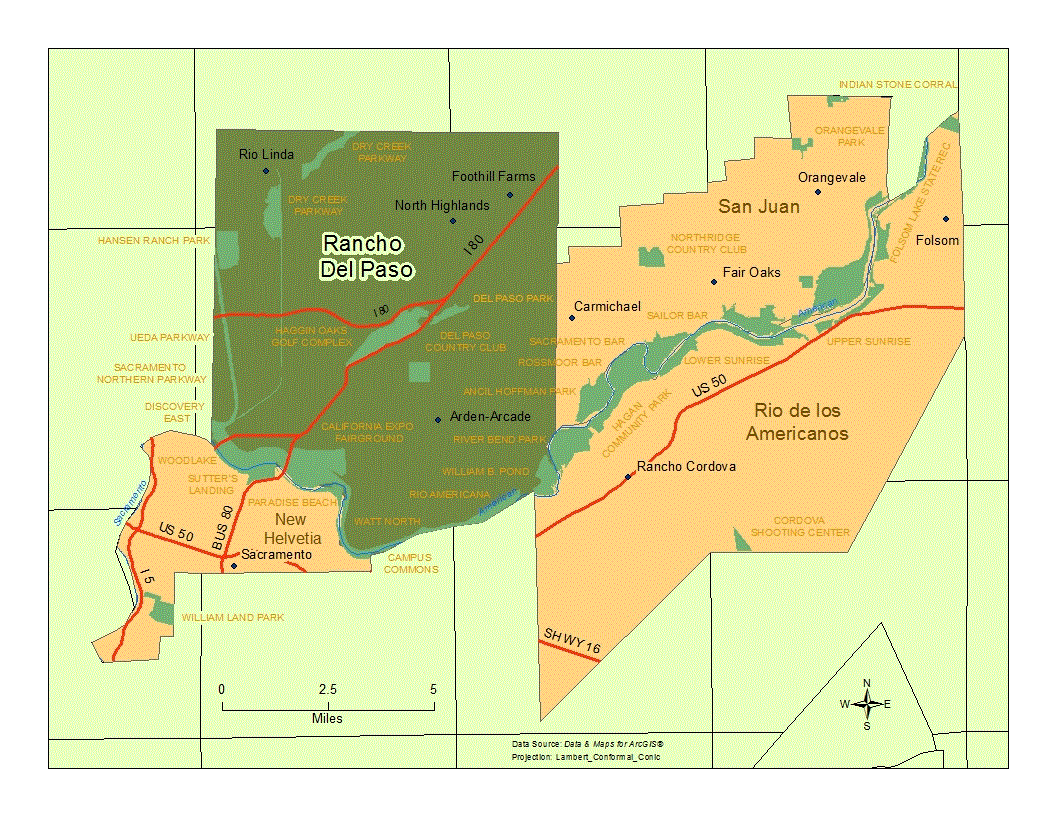
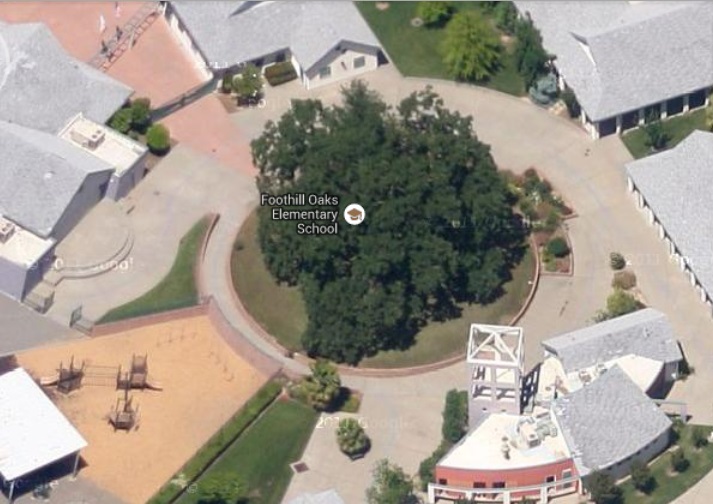
1. Armstrong, Lance, “Rancho Del Paso included future Arden, Carmichael Areas”, Valley Community Newspapers, April 28, 2011.
2. Cowan, Robert G., “Ranchos of California”, Academy Library Guild Fresno, California 1956.
3. Google, Map data Copyright 2013
4. Robillard, Walter G. “Evidence and Procedures for Boundary Location”, pp. 244 - 251, John Wiley & Sons, Inc. 2006.
5. State Lands Commission, “Grants of Land in California Made by Spanish or Mexican Authorities”.
6. U.S. District Court. California, Northern District. Land case 324, page 86; land case map B-660 (Bancroft Library, UC Berkeley).
7. U.S. District Court. California, Northern District. Land case 341 ND, page 143; land case map D-695 (Bancroft Library, UC Berkeley).
8. U.S. District Court. California, Northern District. Land case 359 ND, page 649; land case map F-743 (Bancroft Library, UC Berkeley).
9. U.S. District Court. California, Northern District. Land case 417, page 202; Land case map D-883 (Bancroft Library, UC Berkeley).
10. Wikipedia, “Ranchos of California”.
11. Wikimedia Commons, the free media repository, “Viceroyalty of New Spain after the Adams-Onis Treaty of 1819 (Not including the Spanish overseas territories of the Pacific Ocean)”, A map created using information from the United States Geological Survey, an agency of the United States Department of Interior 1810, 1820 and from the Secretary of the Public Education of Mexico (La Secretaría de Educación Pública de México).